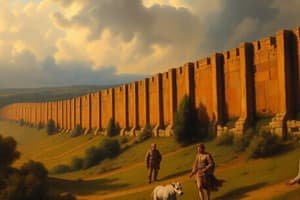Podcast
Questions and Answers
What significant event occurred in 410 AD involving the Visigoths?
What significant event occurred in 410 AD involving the Visigoths?
- Conquest of Gual by the Franks
- Sack of Rome (correct)
- Battle of Adrianople
- Deposition of Romulus Augustulus
The Crisis of the 3rd Century was primarily due to internal strife and succession issues.
The Crisis of the 3rd Century was primarily due to internal strife and succession issues.
True (A)
What reforms did Diocletian implement to stabilize the Roman Empire?
What reforms did Diocletian implement to stabilize the Roman Empire?
Division of the empire into 4 parts, introduction of new capitals, adjustments in taxes and currency.
The emperor who established the Edict of Milan in 313 was __________.
The emperor who established the Edict of Milan in 313 was __________.
Match the following events with their respective years:
Match the following events with their respective years:
Which group was NOT mentioned as part of the invasions during the Crisis of the 3rd Century?
Which group was NOT mentioned as part of the invasions during the Crisis of the 3rd Century?
Roman art during this period was characterized by an emphasis on natural forms and realism.
Roman art during this period was characterized by an emphasis on natural forms and realism.
Who authorized Theodoric to attack Odoacer?
Who authorized Theodoric to attack Odoacer?
Which of the following codes were influenced by Roman and Germanic procedures?
Which of the following codes were influenced by Roman and Germanic procedures?
Ostrogothic King Theodoric did not employ Roman administrators.
Ostrogothic King Theodoric did not employ Roman administrators.
Who became the largest landowner in Italy and standardized the Roman liturgy?
Who became the largest landowner in Italy and standardized the Roman liturgy?
The practice of adopting children by monasteries was known as __________.
The practice of adopting children by monasteries was known as __________.
Match the following rulers or figures with their associated actions or characteristics:
Match the following rulers or figures with their associated actions or characteristics:
Flashcards are hidden until you start studying
Study Notes
The Provincialization of the Empire (c.250-c.350)
- The Crisis of the 3rd Century resulted from invasions by Northern barbarians and Eastern Persian forces, exposing the instability of Rome’s centralized government.
- Over 20 claimants emerged for the throne from 235 to 284, prompting drastic political reforms.
- Key reforms included:
- Establishment of new capitals, starting with Milan by Emperor Maximian.
- Introduction of debased currency leading to inflation.
- Implementation of new taxation policies.
- Division of the Empire into four parts by Diocletian, eventually reduced to two by Constantine.
A New Religion
- The Edict of Milan in 313 legalized Christianity and shifted focus from private worship to public relics and Eucharist ceremonies.
- Church administrators became central figures in the religious transformation.
Art from the Provinces to the Center
- Roman art is noted for its use of light and shadow, atmospheric depth, and a sense of movement.
- Figures in Roman art display a “plastic” quality, emphasizing volume and weight without regard for the viewer.
- Provincial art favored hierarchy, decorative elements, and teaching elements over naturalistic representation.
- By the third century, Roman artists began to imitate provincial styles, exemplified by works like "Embracing Tetrarchs."
The Barbarians
- The Goths were a collection of multiethnic groups; Ostrogoths resided in the East, while Visigoths occupied the West.
- The Goths initially served as federates for Rome but fragmented under the invasions of the Huns in 376.
- The Battle of Adrianople in 378 resulted in the defeat and death of Emperor Valens, highlighting the effectiveness of cavalry in warfare.
- Under Alaric, the Visigoths sacked Rome in 410, influencing religious thought through St. Augustine's "City of God."
- Important historical dates include:
- 378: Battle of Adrianople
- 410: Sack of Rome
- 476: Deposition of Romulus Augustulus by Odoacer.
The New Order/Ruralization of the West
- Barbarians adopted and adapted Roman institutions, leading to the creation of legal codes such as the Visigothic Code and the Burgundian Code, merging Latin with Germanic law.
- The urban middle class declined due to new taxation policies which impoverished town councils (curiales), as wealthy landowners avoided taxation.
- By the seventh century, tax collection became unnecessary for barbarian kings, transforming cities into centers of religion and learning.
- Monasteries gained significance as landowners, facilitating the practice of oblation and community inclusion.
- St. Benedict's influence in 550 and Gregory the Great's standardization of Roman liturgy shaped European Christianity.
Retrenchment in the East
-
Post-476 Eastern Empire displayed both change and continuity; strong rulers like Justinian (527-565) rebuilt infrastructure including Hagia Sophia.
-
The Justinian Plague in the 540s significantly reduced the population.
-
Signs of decline included:
- Theodosius II fortifying Constantinople after the Visigoth sack of Rome.
- Neglected infrastructure and decay of roads under Constantine.
- Invasions by Slavic tribes allowed during Justinian's reign.
-
Important legal frameworks like the Theodosian Code (5th century) and Justinian's Codex (529) and Digest (533) helped reorder Byzantine law.
-
Byzantine territorial expansion was temporarily achieved along with advancements in architectural grandeur.
Studying That Suits You
Use AI to generate personalized quizzes and flashcards to suit your learning preferences.





